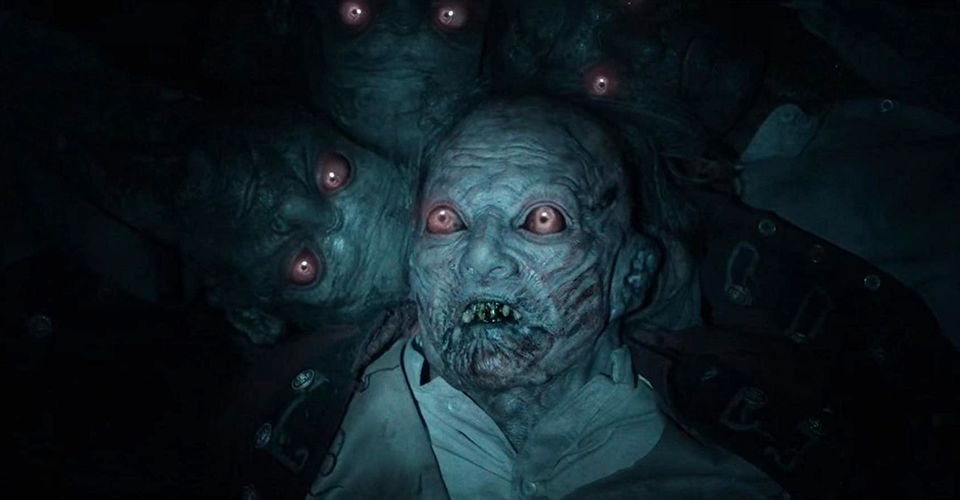Betaal Interview: Patrick Graham

Betaal is a recent addition to the growing zombie sub-genre that finds a very unique perspective to explore the frightening territory. Patrick Graham, the creator of Betaal, is particularly excited to push the sub-genre to challenging new places.
Zombies have been around in pop culture for nearly a hundred years and the treatment of the undead has understandably grown a lot since its inception. There’s been a growing trend that pairs zombies together with the horrors of war and plenty of films, TV series, and even video games have found success with the niche. Netflix’s Betaal is the latest example to indulge in such ideas. The frightening series not only pays service to many familiar zombie tropes, but also utilizes its Indian heritage to tell a story that’s specific to their country and has something powerful to say. Betaal is far more than just frightening visuals, which feels like something that Blumhouse strives for as they try to highlight atypical horror.
Netflix’s Betaal tells a challenging, emotional story over the course of four powerful episodes and it helps shine a light on the kind of monster movie that strays from the norm. There are clearly a lot of emotional topics that are present in the series, and it feels like the story means a lot to Patrick Graham, who created the series as well as co-wrote and co-directed with Suhani Kanwar and Nikhil Mahajan, respectively. ScreenRant was fortunate to talk with Patrick Graham about his inspirations for this project, why zombies were the best approach for this story, and where a possible sequel could be headed.

ScreenRant: Everyone is doing zombies! Why did you think zombies would be the best conduit for the story that you wanted to tell here?
Patrick Graham: You’re absolutely right. They’re so popular at the moment, but the thing is that in India we really don’t have them. So I thought it would be fun for India to kind of give its own take on the zombie genre with something kind of idiosyncratic to Indian mythology and Indian horror. I thought it would be a fun exploration of the zombie genre from an Indian point of view.
ScreenRant: The idea of all of the zombies seeing and feeling the same thing as a hive mind is a unique twist on the genre, too. How did that come about?
Patrick Graham: With the myth of the Betaal, there are many different iterations of what a Betaal is and how that character operates in Indian folklore. One of the primary concepts of what a Betaal is that it’s supposed to be the “Lord of the Spirits.” So I thought that made things quite interesting. In the text there are all of these themes about taking orders and giving orders. I think it was great that the Betaal can be an example of the ultimate “order giver.” Not only does he give orders to his army, but it’s almost like his army is a part of him. So I thought thematically that works quite nicely with the theme of taking orders.
ScreenRant: Talk about the look for the monsters that are found in the tunnels. Where did that look come from and did you consider any other approaches?
Patrick Graham: I just didn’t want to do the same old thing or for these zombies to look familiar. I didn’t want it to just look like Dead Snow. It can be easy to fall into a traditional comfort zone there. British Redcoat zombies can look awfully similar to Nazi zombies. I didn’t want to just have these rotting corpses and I thought that there should be more of an Indian flavor present. I was literally looking at Indian folklore and also if you check out these statues of demons in India you’ll see that they all have these bulging eyes. I always thought that was an evocative image and so I wanted to touch on that with these bulging eyes that always kind of glow.
I thought a lot about movies like The Fog—these movies that aren’t necessarily cheesy, but have this “VHS horror” vibe from the ’80s. I just love making the monsters just a little bit kitsch. But yes, there was a lot of work to give them more of an Indian slant. Their fangs curve to the sides, which is a bit of this Indian appearance, and their eyes are bulging out of their faces. I wanted to create a monster that felt a little more novel than just some rotting corpse.
ScreenRant: It’s great. I love that it’s this sort of zombie-vampire hybrid. The look kind of made me think of the vampires in Fright Night, too.
Patrick Graham: The original TV movie of Salem’s Lot was a big influence, too. The vampires in that have a really distinct look that also uses these big, glowing eyes.
ScreenRant: I think the pacing of the series is one of its greatest assets. Was it hard to figure out how to structure these episodes and went to ramp up or turn down the action?
Patrick Graham: That’s interesting because it’s only four episodes, but I very much wanted it to be a constant edge of your seat experience. So we really had a lot of plot strands in play in order to keep the tension present and the pacing aggressive at all times. Even though it’s kind of short at only four episodes, we still built it like a series with many plot lines layered into it.
ScreenRant: Was this always developed as a series? At some point was there a simplified version that was attempted as a feature film?
Patrick Graham: It was always planned as a series. Ghoul—a previous and similar series that I did for Netflix—that started as a movie before it was turned into a series. With Betaal we very much structured and intended for it to be a series.
ScreenRant: In both Betaal and Ghoul you pair these supernatural stories with something as real and prescient as war crimes and imperialism. Why was that a dynamic that you wanted to explore?
Patrick Graham: I like touching on issues that I personally find interesting and relevant. I want to feel passionate about what I’m working on in order to give it that extra emotional charge. I just find it more appealing to write and direct something that I feel that level of attachment towards. With Ghoul, and this series that I worked on afterwards, Leila, there was a real reaction from the audience that thought that some of the political content touched on was objectionable.
So with Betaal I wanted to step back away from that slightly and make the themes a bit more generic in the sense that I wasn’t criticizing anything that I thought that people would take offense towards. Just because you’re wearing a uniform doesn’t mean that you can get away with anything, which I think is a bit more of a universal theme. India is of course a country with a volatile audience so you do get these armies of right wing trolls. It’s volatile, but it’s also very kind as well.
ScreenRant: You do make it pretty universal. In the end it’s a lot more a story about the difficulties of someone with PTSD who then has to go on to mow down these zombies. It’s a fascinating mental place to put the character in.
Patrick Graham: Absolutely and I’m glad that you picked up on that because one of our directions to Viineet Kumar, who played Sirohi, is that he’s in this PTSD-like situation and that the way that this effects his confidence comes across with his performance in the show.
ScreenRant: There’s such lore present here in terms of the mountain’s history, curse, and traditions. Where did you draw all of that from and find inspiration? Is it a lot of mixing real life traditions with your own ideas?
Patrick Graham: I had to try and fit the Betaal folklore into the story of the show. The story was already written and formed before we got the Betaal on board. It’s the same thing that I did with Ghoul, really, where I had the story in mind and then retrofitted the monster to fit the story. However, after developing all of this the Betaal folklore obviously became very important and more deeply interwoven into the story. It just seemed to work that the Betaal is this demon who has a bunch of smaller demons working under his command.
There’s also a very famous story in India called Vikram aur Betaal where a person learns lessons from this vampire that he has to carry away from a cemetery on his back. So there’s imagery of the Betaal on some of the characters’ back and whispering and manipulating them that’s meant to call back to that story.
ScreenRant: You include the media reporting on this crisis as it happens. Why did you also want to convey that perspective during this story?
Patrick Graham: As with everywhere right now, there’s this conflict between fake news and what’s real and what isn’t. In India there’s an extreme right wing press that’s just ripe for parody because it’s so reactionary and sensationalized. You get these pundits who just scream into the screen, so it was fun to touch on that and feature a screaming news anchor to good effect.
ScreenRant: The series goes out on quite an ending. Do you have plans for a continuation to this story and what a sequel might explore?
Patrick Graham: I think this was always considered to most likely be a one-off, but of course, the open ending is there. It’d be so fun to explore a zombie invasion of India on a much larger scale. I have ideas of where that could go. It would obviously be a much larger operation and it’d be fun to open the scenario up to other armies of invaders from the past, since India has such a history of being invaded and invaded again by different groups of people throughout history. So there are lots of different zombie armies that you could bring into the picture and you could actually make quite a nice story about India uniting over a common threat. In India right now unity is something that’s really needed.
ScreenRant: I love that. That’d be such a creative way to have people coming together over this common undead enemy. Finally, what are some of your favorite horror films of the past year? What have you been getting excited over?
Patrick Graham: I loved this French series on Netflix called Marianne. That genuinely scared me. I’ve seen so much horror nowadays that you’re able to anticipate how much scares will play out, but I thought that Marianne did it so well. I really enjoyed that series. Also just from a genre perspective, I recently watched The Vast of Night and that was just wonderful. It shows how innovative cinema can still be in this day and age. Other than that, my favorite horror of the past few years would have to be Hereditary. I thought that was such an amazing film on every level.
Betaal is available to stream on Netflix.
About The Author

















